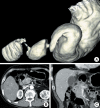Brunner's gland hyperplasia: treatment of severe diffuse nodular hyperplasia mimicking a malignancy on pancreatic-duodenal area
- PMID: 18583897
- PMCID: PMC2526515
- DOI: 10.3346/jkms.2008.23.3.540
Brunner's gland hyperplasia: treatment of severe diffuse nodular hyperplasia mimicking a malignancy on pancreatic-duodenal area
Abstract
Brunner's gland hyperplasia is a benign tumor of the duodenum and it is rarely associated with clinical symptoms. We report on a 64-yr-old man with Brunner's gland hyperplasia who had undergone a duodenocephalo-pancreatectomy. The reason is that he presented upper gastrointestinal obstructive symptoms and the esophagogastroduodenoscopic finding revealed the lesion to be an infiltrating type mass on the second portion of the duodenum with luminal narrowing. An abdominal computed tomography showed a 2.5 cm-sized mass in the duodenal second portion with a suspicious pancreatic invasion and 7 mm-sized lymph node around the duodenum. Duodenocephalopancreatectomy was successfully performed. Histological examination revealed a Brunner's gland hyperplasia. The final diagnosis was the coexistence of Brunner's gland hyperplasia and pancreatic heterotopia with a pancreatic head invasion. The literature on Brunner's gland hyperplasia is reviewed.
Figures



Similar articles
-
Unexpected cause for duodenal obstruction: Brunner's gland hyperplasia.Pathologica. 2017 Dec;109(4):414-417. Pathologica. 2017. PMID: 29449737 Review.
-
Brunner's gland adenoma of duodenum: report of two cases.Int J Clin Exp Pathol. 2015 Jun 1;8(6):7565-9. eCollection 2015. Int J Clin Exp Pathol. 2015. PMID: 26261670 Free PMC article. Review.
-
Hyperplasia of Brunner's glands of the duodenum.Am Surg. 1977 Apr;43(4):246-50. Am Surg. 1977. PMID: 851297
-
Brunner's gland hamartoma: 'over-treatment' of a voluminous mass simulating a malignancy of the pancreatic-duodenal area.JOP. 2005 Jul 8;6(4):348-53. JOP. 2005. PMID: 16006686
-
A case of Brunner's gland adenoma mimicking tumors induced from head of the pancreas.Pan Afr Med J. 2018 Jan 25;29:78. doi: 10.11604/pamj.2018.29.78.11502. eCollection 2018. Pan Afr Med J. 2018. PMID: 29875959 Free PMC article.
Cited by
-
Brunneroma: A Case of Uncommon Gastrointestinal Bleeding in a Young Adult.Cureus. 2023 Feb 17;15(2):e35127. doi: 10.7759/cureus.35127. eCollection 2023 Feb. Cureus. 2023. PMID: 36945276 Free PMC article.
-
Brunner's Gland Hamartoma of the Duodenum: A Literature Review.Adv Ther. 2021 Jun;38(6):2779-2794. doi: 10.1007/s12325-021-01750-6. Epub 2021 Apr 29. Adv Ther. 2021. PMID: 33914269 Free PMC article. Review.
-
A case of giant Brunner's gland hyperplasia of the duodenum diagnosed by endoscopic ultrasonography-guided fine needle biopsy.Clin J Gastroenterol. 2025 Aug 14. doi: 10.1007/s12328-025-02181-4. Online ahead of print. Clin J Gastroenterol. 2025. PMID: 40810761
-
Saving from unnecessary pancreaticoduodenectomy. Brunner's gland hamartoma: Case report on a rare duodenal lesion and exhaustive literature review.Ann Med Surg (Lond). 2017 Mar 29;17:43-49. doi: 10.1016/j.amsu.2017.03.034. eCollection 2017 May. Ann Med Surg (Lond). 2017. PMID: 28408987 Free PMC article.
-
Giant Duodenal Brunneroma: Report of a Rare Case and Review of the Literature.Am J Case Rep. 2024 Dec 18;25:e945913. doi: 10.12659/AJCR.945913. Am J Case Rep. 2024. PMID: 39693272 Free PMC article. Review.
References
-
- Tan YM, Wong WK. Giant Brunneroma as an unusual cause of upper gastrointestinal hemorrhage: report of a case. Surg Today. 2002;32:910–912. - PubMed
-
- Peetz ME, Moseley HS. Brunner's gland hyperplasia. Am Surg. 1989;55:474–477. - PubMed
-
- de Silva S, Chandrasoma P. Giant duodenal hamartoma consisting mainly of Brunner's glands. Am J Surg. 1977;133:240–243. - PubMed
-
- Bastlein C, Decking R, Voeth C, Ottenjann R. Giant Brunneroma of the duodenum. Endoscopy. 1988;20:154–155. - PubMed
-
- Franzin G, Musola R, Ghidini O, Manfrini C, Fratton A. Nodular hyperplasia of Brunner's glands. Gastrointest Endosc. 1985;31:374–378. - PubMed
Publication types
MeSH terms
LinkOut - more resources
Full Text Sources
Medical

